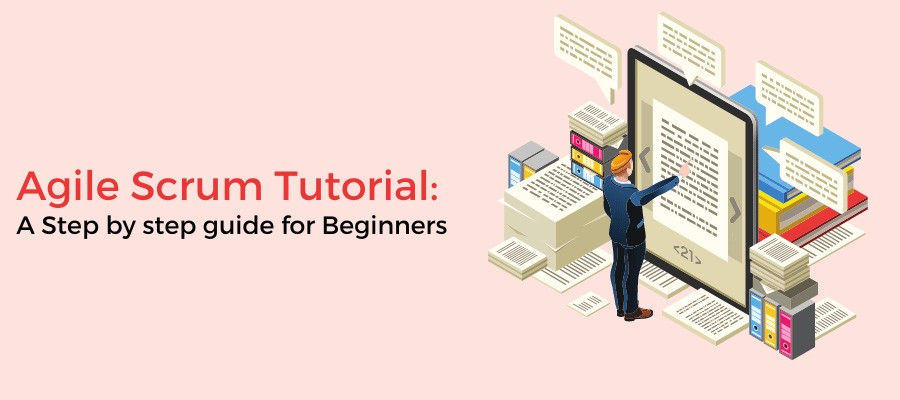Agile Scrum Tutorial A Step-by-step guide for Beginners

Agile and Scrum are often used interchangeably, but they have distinct meanings. Agile philosophy emphasizes Continuous Improvement and incremental value delivery. On the contrary, Scrum is a framework for implementing Agile Principles. If you are an Agile Practitioner and what to learn Agile Scrum, this guide is for you! Keep reading as we provide a step-by-step guide to mastering Agile Scrum concepts.
Agile and Scrum: Understanding the Difference
Agile is a philosophy that values individuals and interactions, working software, customer collaboration, and responding to change. It promotes flexibility, adaptability, and customer-centricity. On the other hand, Scrum is a framework that follows the Agile philosophy. It provides a structured approach to managing and delivering complex Projects. While Agile is a broader concept, Scrum offers specific guidelines and practices to implement Agile Principles effectively.
Explaining The Scrum Framework:
The Scrum Framework is a popular Agile Project management approach for teams to collaborate and deliver value continuously. Scrum promotes transparency, inspection, and adaptation through defined roles, events, artifacts, and principles. The Scrum Framework has three main components:
1. Values:
The Scrum framework is built on the foundation of empiricism, which emphasizes making decisions based on observation, experimentation, and evidence. Scrum adopts lean thinking principles, focusing on eliminating waste and maximizing value for the customer.
2. Principles:
Scrum encourages Agile Teams to continuously learn from their experiences and apply them to improve their Productivity. Scrum embraces change and aims to minimize waste by prioritizing value-adding activities and eliminating unnecessary work.
3. Practices:
Scrum follows Agile Practices like Daily Scrum or Sprint Planning to maintain clear transparency among operations teams and Developers. These practices promote a healthy work culture in the organization.
The Members of The Scrum Team:
The Scrum Team consists of three main members:
1. Product Owner:
The Product Owner represents the customer's interests and ensures the team delivers a valuable Product. He creates the Product Roadmap and defines the Product Goal for Agile Teams, making decisions about the Product.
2. Scrum Master:
The Scrum Master facilitates the Scrum process and ensures adherence to Scrum principles and practices. He guides the team in self-organization, continuous improvement, and removing any impediments they may face.
3. Developers:
Developers are responsible for delivering the Product Increment at the end of each Sprint. Developers collaborate closely with the Product Owner and Scrum Master to understand requirements and deliver high-quality results.
Introduction to Scrum Artifacts:
Scrum Artifacts are essential components of the Agile Scrum Framework. Here are the most common Scrum Artifacts:
1. Product Backlog:
The Product Backlog is a dynamic and prioritized list of Features, requirements, enhancements, and User Stories that capture the customer's needs and desires. It serves as the team's "To Do" list and provides a clear overview of the work needed.
2. Sprint Backlog:
The Sprint Backlog is a subset of items from the Product Backlog that the Developers commits to completing within a Sprint. It includes the tasks and activities required to deliver the selected items and achieve the sprint goal.
3. Increment:
The Increment is the primary measure of progress and provides tangible value to the customer. The Increment is the usable end-Product resulting from a sprint. It represents the sum of all the completed and integrated Product Backlog items and any additional work necessary to make them potentially releasable.
Explaining Scrum Ceremonies or Events:
Scrum ceremonies are regular meetings and events that facilitate the Scrum process. They include:
- Backlog Organization: The Product Owner maintains the Product Backlog by continuously prioritizing and refining the list of work items.
- Sprint Planning: The entire Developers collaborates to plan the work for the upcoming sprint, ensuring alignment with the sprint goal.
- Sprint: A time-boxed period during which the Developers works to complete the committed work items. The length of a sprint is typically two weeks.
- Daily Scrum or Stand-up: A brief daily meeting where team members synchronize their work, discuss progress, and identify obstacles.
- Sprint Review: A session at the end of each sprint where the Developers showcases the completed work to stakeholders and gathers feedback.
- Sprint Retrospective: A meeting where the Scrum Team reflects on the sprint and identifies improvements for the next sprint.
Core Agile Scrum Values:
Scrum values are essential for fostering a collaborative and Productive environment. Here are the core Agile Scrum values:
- Commitment: Each team member commits to their tasks and communicates progress effectively.
- Courage: Team members dare to question the status quo and make improvements.
- Focus: The team focuses on the sprint goal and works together to achieve it.
- Openness: Transparent communication and sharing of information are encouraged within the team.
- Respect: Team members respect each other's expertise, ideas, and contributions.
Summing Up The Learning:
Agile and Scrum provide a robust framework for delivering value flexibly and customer-centric. By following the step-by-step guide outlined in this tutorial, beginners like you can gain a solid understanding of Agile and Scrum principles. Begin your Agile Learning journey and apply the Scrum values in your Agile Projects. Remember to remain adaptable and keep Learning continuously. Embrace the core principles of Agile and Scrum for long-term success as an Agile Leader!
Reference
- https://www.Scrum.org/resources/ways-learn-about-Scrum



